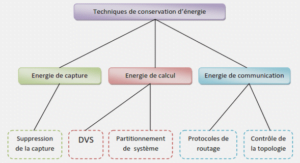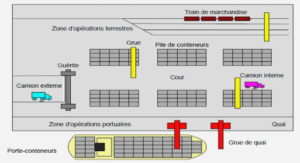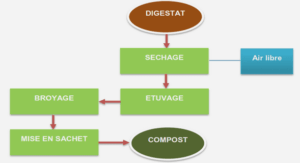L’étude environnementale
Le deuxième objectif du projet est d’analyser l’histoire climatique, environnementale,et océanographique de la région lors de l’Holocène récent, particulièrement les derniers ::::; 2500 ans, en utilisant les mesures magnétiques, physiques et granulométriques des carottes. En raison des vitesses de sédimentation élevées des sites d’échantillonnage, mesurées entre 220 et 320 cm/ka dans une étude récente au même emplacement mené par Durantou et al. (2012), cette étude présente des archives climatiques et océanographiques de résolution temporelle exceptionnelle en comparaison avec les autres régions de l’Arctique. Comme c’est le cas pour le paléomagnétisme, une résolution temporelle élevée est nécessaire pour investiguer les variations environnementales qui ont lieu à des échelles de temps plus courtes ou lors des processus cycliques séculaires à décennaux. L’emplacement des deux carottes promet une perspective intéressante concernant les processus océanographiques de la région puisque ce secteur n’est pas uniquement sous l’influence du fleuve Mackenzie, mais également des courants marins profonds et de surface (Figure 4). La carotte la plus au large du delta présente un intérêt particulier car cette zone est connue pour être affectée par le courant profond de Beaufort. Ce courant originaire de l’océan Pacifique par l’intermédiaire du détroit de Béring s’écoule typiquement vers l’est le long de la marge continentale de Beaufort (Aagaard, 1984; Carmack et Macdonald, 2002; Pickart, 2004). De plus, la sédimentation du site le plus profond est potentiellement sensible à certains traits de la circulation de surface, notamment le tourbillon cyclonique de Beaufort dominant dans la région (e.g., Pickart, 2004). En revanche, le site moins profond est plus influencé par des courants de surface poussés par le vent. Il y a ainsi deux régimes distincts, le premier s’écoulant vers le nordest en suivant la côte et le second orienté vers l’ouest en direction du delta et de la Fosse du Mackenzie (e.g., Harper et Penland 1982; Hill et al., 1991; Carmack et Macdonald , 2002). Le panache (plume) de sédiment créé à l’embouchure du fleuve n’occupe que la partie sommitale de la colonne d’eau (les 2-3 premiers mètres). Ce dernier est ensuite poussée vers l’est par les courants de surface provenant du remplissage préférentiel dans la partie est de la fosse (e.g. , Doraxan et al., 2012). Un des objectifs de ce projet de maîtrise est donc d’étudier les diverses caractéristiques océanographiques et hydrographiques relatives aux deux sites et d’évaluer ainsi l’impoliance des variations de profondeur et de distance à la côte.
Regional Geologie Setting
Sedimentology The continental seas and marginal shelves of the Western Arctic are ideal locations for paleomagnetic and paleoclimatic studies due to their high levels of sedimentation relative to much of the Arctic Ocean (Darby et al , 2006). The Mackenzie River, the fourth largest Arctic river in terms of freshwater discharge (Iargest in the North Ameri can Arctic), is the largest single source of sediment to the Arctic and dominates sedimentation on the Beaufo li Shelf, carrying an annual load of::::; 125 Mt of sediment (Hill et a l. , 199 1; Carson et al. , 1998; Macdonald et al. , 1998). The Mackenzie Trough itselfexhibits the highest rate of sediment accumulation in the region, often reaching a few millimeters per year (e.g. , Hill et al. , 199 1; Macdonald et al., 1998; Richerol et al., 2008; Scott et al., 2009; Bringué and Rochon, 201 2; Durantou et al. , 201 2), making the feature an attracti ve candidate fo r recent, high-resolution studies such as this, as compared to many other Arctic regions having generally lower sedimentation rates (e.g., Rochon and de Vernal, 1994; Ledu et al. , 2008). In fact, rates ranging from 220 to 320 cm/ka through the late Holocene were recently measured at the location of this study (Durantou et al., 20 12). The trough holds between 30 and 50 m of Holocene sediment overlying late Pleistocene deglacial deposits (Blasco et al. , 1990; Hill et al., 199 1; Batchelor et al., 201 3). High-reso lution seismic reflection data reveal the continuous, parallel, and low-amplitude internai refl ectors of this uppermost sequence, suggestin g deposition primarily from the verti cal accretion of sediments out of suspension (Elverh0i et al. , 1980; Dowdeswell et al. , 1997; Kleiber et al., 2000; Batchelor et al., 2013). Signs of gentle progradation are also apparent, and support previous suggestions by Hill et al. (1 991 , 1996) of a preferenti al eastward infi lling of the trough (Batchelor et al. , 2013).The postglacial sediment load of the Mackenzie River consists primarily of silt and some clay with a minimal percentage of fine sand, in contrast to the significa ntly sandier sed iments of the Mackenzie Shelf (Blasco et al. , 1990; Carson et al., 1998; Hill et al. , 1996, 200 J; Barletta et al. , 2008; Scott et al. , 2009). Sedimentation offshore of the delta, i.e. at depths greater than ::::; 10 m, occurs principall y through the deposition of fi ne pat »ticles out of suspension (Hill et al., 199 1), and cores at these depths revea l sediment fac ies consisting almost entirely of fin e, bioturbated mud, breaking down into a sil t/clay ratio of::::; 2 (e.g., Vil ks et al. , 1979; Pelleti er, 1984; Hill et al. , 2001 ; Ri cherol et al., 2008; Scott et al. , 2009; Jerosch et al. , 201 2; Durantou et al. , 201 2). In general, postglacial sedimentation on much of the North American Arctic continental margin is dom inated by fi ne-grained, fluvially and glac iall y eroded sediments of continenta l terrain, whi ch is often rich in idea l magnetic remanence carriers such as magnetite and titanomagnetite (Bischof and Darby, 1997, 1999; Darby, 2003; Darby and Bischof, 2004; Stoner and St-Onge, 2007; Barletta et al., 2008). The Mackenzie River accounts for ;:::: 95% of sedimentation on the Beaufort Shelf, though other significant contributions are derived from coastal erosion and several Yukon rivers (Hill et aL, 1991). Two features in particular, the highly erosive Herschel Island and the Babbage River in northern Yukon, could provide minor additional sources of sediment to the study area, and are especially close to site 680. Coastal erosion, though asmail contribution to ove rail sedimentation by volume, accounts for the majority of sand and gravel found on the Beaufort Shelf, and is also known to be the source of larger-grained deposits on Herschel Island (Hill et aL, 1991 ; Lantuit and Pollard, 2008).
Hydrology and oceanography The Mackenzie Delta is a vast, complex system of distributary channels extending about 210 km from the mouth of the river and spanning a width of about 87 km (Lewis, 1988). It forms a shallow shelfroughly 120 km wide and 530 km long, with the Mackenzie Trough carved along its western side (Carmack et al., 2004). The head of the Mackenzie Trough lies about 80 km farther to the northwest form the lower delta plain, converging gradually with the long pro-delta slope. The high rates of freshwater discharge (ranging from 249 to 333 km3 annually), which fluctuate strong1y seasonally, contribute strongly to the highly variable quality of surface circulation patterns near the delta (Macdonald et aL, 1998; Hill et al., 200]; Dittmar and Kattner, 2003). However, offshore of the delta other Arctic circulation patterns play an increasingly dominant role. One of the more prominentfeatures in surface circulation in the Western Arctic is the Beaufort Oyre, an anticyclonic gyre (dominated by westward flow) along the nOlihern edge of the Mackenzie and Beaufort shelves (Pickart, 2004). Beneath the Beaufort Oyre, halocline waters flow a10ng the continental margin from the Pacific Ocean in Beaufort Undercurrent, which is generally cyclonic (dominated by eastward flow) but known to reverse its direction (Carmack and Macdonald, 2002; Pickart, 2004). Sedimentation on the continental shelf largely occurs through the transport of fine particles in suspension in the Mackenzie ,plume, which Dccupies a thick (2-3 m) surface-l ayer and is therefore strongly influenced by wind-driven surface currents. There are two dominant regimes: one characterized by an along-shore east-northeastward flow and another by a westward flow toward the Mackenzie Trough (Harper and Penland, 1982; Hill et al., 1991 ; Carmack and Macdonald , 2002; Macdonald et al. , 2002; Doraxan et al., 2012). These currents grow weaker with depth, but on the outer shelf, i.e. at depths > 60 m, a stronger current regime is again observed due to the added influence of another easterly current, possibly an extension of the Beaufort Undercurrent from the Alaskan shelf (Aagaard, 1984; Hill et al., 1991 ; Pickart, 2004). This contribution, along with that of wind-driven surface currents tlowing in the same direction, results in a net eastward drift of the Mackenzie River’s plume of suspended sediment, and therefore a preferential eastward infilling of sediment in the Trough (Hi ll et al. , 1991 , 1996, 2001; Carmack and Macdonald, 2002). These deposition patterns are readily apparent in the bathymetry of the area, with the Trough axis v isibly curving from northwest to north (Figure 1).
Lithology and Stratigraphy
Both cores consist almost entirely of homogeneous fine-grained mud, uniformly gray-brown to olive-gray clayey silt. Using the geometric method of moments function in the GRADISTAT software, the sediment in both cores was c1assified as muddy fine silt, and was poorly sorted for the majority of both cores (2 :s cr :s 4) (Blott and Pye, 2001). Noticeably poorer sOl1ing is observed throughout core 680, with average values of cr = 3.32, as compared to the core 690 average of cr = 2.82. Core 680 also had a slightly larger average grain size, while core 690 exhibits uniformly fine sediment throughout the core, with the exception of the 20 cm mark, where a significant proportion of silt and a very small am ou nt of sand are also observed (Figure 3). In core 690 a uniform, dark gray color is observed down the entire core (Munsell color value of 2.5Y 411). Color is relatively uniform in core 680, varying from grayish brown (2.5Y 5/2) at the top of the core, to very dark gray (2.5Y 311), to gray (2.5Y 511), and finally returning to dark gray (2.5Y 4/1) near the base of the core. No distinct boundaries or rapid changes are visually observable, and furthermore the minor variations could be attributable to dried and altered condition of the core 680 u-channels, which made the judgment of color challenging. The overall uniformity of color in both cores is supported by spectrophotometry profiles. For example,changes in L * vary between ::::; 2S and 4S for both cores, with the exception of large and small outlying values representing anomalous features such as shell fragments and cracks in the record . Traces ofbiotrubation are apparent regularly throughout both cores. No welldefined lithologic unit boundaries are apparent in either core (Figure 3). These color, grain size, and sorting characteristics are typical of Arctic postglacial shelf deposits (e.g., Syvitski , 1991; Darby et al. , 2006; Keigwin et al., 2006), and the lithology is consistent with other post-glacial sediment cores sampled in the southern Beaufort Sea (e.g., Rochon et al., 2003; Barletta et al., 2008; Lisé-Pronovost et al., 2009; Bringué et al., 2012;Durantou et al., 2012).
|
Table des matières
REMERCIEMENTS
RÉSUMÉ
ABSTRACT
LISTE DES TABLEAUX
LISTE DES FIGURES
INTRODUCTION GENERALE
PALEOMAGNETIC STUDY OF HOLOCENE SEDIMENTS FROM THE MACKENZIE RIVER TROUGH, BEAUFORT SEA
CONCLUSION
RÉFÉRENCES BIBLIOGRAPHIQUES
![]() Télécharger le rapport complet
Télécharger le rapport complet






